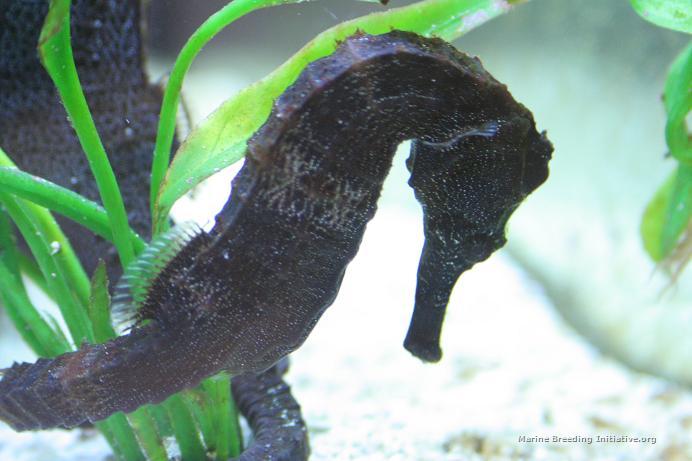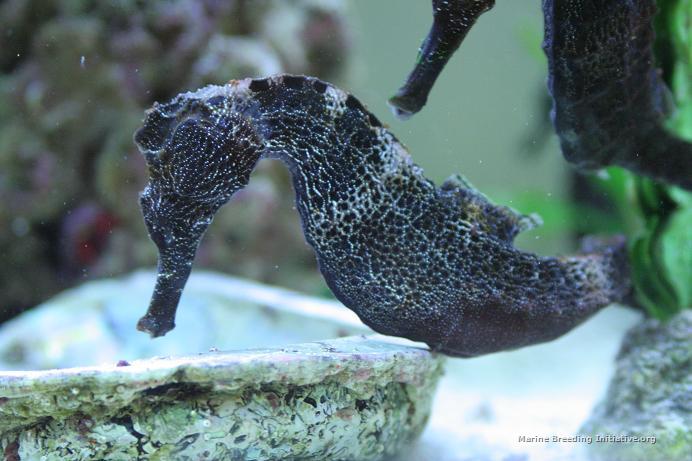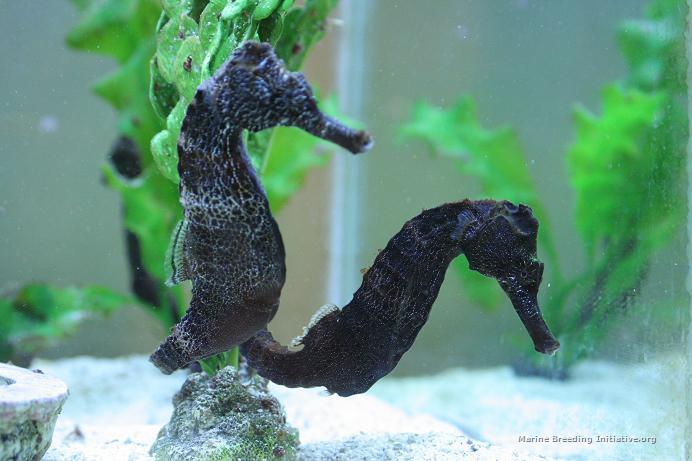Change Page: < 123 > | Showing page 2 of 3, messages 21 to 40 of 45 - powered by ASPPlayground.NET Forum Trial Version
Author
|
Message

|
 Re: Breeding Journal, Species: Hippocampus reidi
Sunday, September 5, 2010 12:31 AM
Re: Breeding Journal, Species: Hippocampus reidi
Sunday, September 5, 2010 12:31 AM
( permalink)
Yes, exactly.
--Andy, the bucket man. "Not to know the mandolin is to argue oneself unknown...." --Clara Lanza, 1886
|
|
|
 Re: Breeding Journal, Species: Hippocampus reidi
Sunday, September 5, 2010 1:26 AM
Re: Breeding Journal, Species: Hippocampus reidi
Sunday, September 5, 2010 1:26 AM
( permalink)
Thanks for the confirmation. I did some calcs on the ammonia control:
ClorAm-X weighs 5.33 grams / tsp.
16 tsp = 85.33 grams
According to the label, it takes 0.0319 grams of ClorAm-X to neutralize 1 mg of ammonia.
Therefore, that 16 tsp of ClorAm-X is enough to neutralize 85.33 / 0.0319 = 2675 mg of ammonia.
That means each ml of the solution will neutralize 2675 / 1000 = 2.675 mg of ammonia.
Translating this for users of AmQuelPlus:
According to the label, 5 ml of AmQuelPlus will neutralize 1.2 mg of ammonia in 40 liters of water.
That means that 5 / 40 = 0.125 ml of AmQuelPlus will neutralize 1.2 mg of ammonia.
Which means that 0.125 / 1.2 = 0.1042 ml of AmQuelPlus will neutralize 1.0 mg of ammonia.
So, the 2.675 mg of ammonia referenced above will be neutralized by 0.1042 * 2.675 = 0.28 ml of AmQuel Plus.
So, basically, we can give a rough equivalent of 1/4 (1/3 if you want to be extra safe) ml of AmQuelPlus = 1 ml of the ClorAm-X solution for ammonia control.
The AmQuelPlus has the additional benefits of being pH buffered, and it also helps control nitrite, too!
|
|
|
 Re: Breeding Journal, Species: Hippocampus reidi
Tuesday, September 7, 2010 12:32 AM
Re: Breeding Journal, Species: Hippocampus reidi
Tuesday, September 7, 2010 12:32 AM
( permalink)
Well, my O. marina cultures are ramped up now, and I'll be feeding some to my Apocyclops tonight. As an aside, I have been doing some more experimentation, and initial results indicate that Apocyclops may do well on just live Nannochloropsis, so for those who just grow Nanno, Apocyclops cultivation may be an option!
My most recent batch of H. reidi fry born last Thursday morning (Larry & Freckles offspring) are divided into two containers: one with about 100 fry that are being fed primarily Apocyclops in T-Iso "green water", with some rotifers and some enriched BBS, and another container that has been fed only rotifers for the first 5 days. Late tonight, the end of Day 5, I did a big water change and added a few Apocyclops and enriched BBS for them to eat, too. The rotifer batch have been feeding quite nicely on the rotifers. I've been culturing the rotifers with Roti-Grow Plus, and have been enriching them for 12 hours +/- 6 hours with N-Rich. I've also been using the Reed Mariculture product "Roti-Green" on them, as a preserved green water product.
My initial observations about Roti-Green: The first time I used it, I used too much. Immediate results were very negative! Immediate "scratching" behavior, like what I see with ammonia or nitrite toxicity, started within just minutes. The fry stopped eating. Another batch of some 30 "warning babies" that I also used the Roti-Green on with too much dosage were wiped out within about 1/2 hour. The Roti-green had been stored in the fridge for about a week after receipt. I don't think it had had a chance to turn bad. I was horrified, and did a huge water change on the rotifer-eating batch of fry to dilute the Roti-Green, and things immediately got much better! Over the next day, I saw almost every fry had Kelley Green guts instead of the usual brownish/orangish color of the ones eating rotifers. I am continuing to use the Roti-Green, but much more cautiously. I've frozen most of it in ice cube trays. The dosage I am using is 1/2 ml / Gallon. The Roti-Green product does seem to keep the rotifers nicely enriched. This evening, after the major water change, I sieved the Roti-Green maintained rotifers, and they looked nice and green in the sieve. I was impressed! Initial impressions of this product is that it does a good job of keeping the rotifers enriched, as long as you use it in moderation.
|
|
|
 Re: Breeding Journal, Species: Hippocampus reidi
Tuesday, September 7, 2010 9:02 AM
Re: Breeding Journal, Species: Hippocampus reidi
Tuesday, September 7, 2010 9:02 AM
( permalink)
I just gave up on a batch of Apocyclops that I was culturing only with algae paste. Individuals in the culture lasted surprisingly long, but it never thrived and it needed lots of intense work. It certainly needed daily 100% water changes. If I went to two days, the culture would take a big hit. But they were still reproducing in there for 2-3 weeks before the whole thing started to peter out.
--Andy, the bucket man. "Not to know the mandolin is to argue oneself unknown...." --Clara Lanza, 1886
|
|
|
 Re: Breeding Journal, Species: Hippocampus reidi
Sunday, September 19, 2010 3:46 PM
Re: Breeding Journal, Species: Hippocampus reidi
Sunday, September 19, 2010 3:46 PM
( permalink)
|
|
|
 Re: Breeding Journal, Species: Hippocampus reidi
Friday, November 12, 2010 11:35 AM
Re: Breeding Journal, Species: Hippocampus reidi
Friday, November 12, 2010 11:35 AM
( permalink)
Jim,
Do you have any pics of the parents?
|
|
|
 Re: Breeding Journal, Species: Hippocampus reidi
Monday, January 3, 2011 9:19 PM
Re: Breeding Journal, Species: Hippocampus reidi
Monday, January 3, 2011 9:19 PM
( permalink)
Jim,
Do you have pics of the parents so that we can confirm the species?
|
|
|
 Re: Breeding Journal, Species: Hippocampus reidi
Monday, January 3, 2011 11:38 PM
Re: Breeding Journal, Species: Hippocampus reidi
Monday, January 3, 2011 11:38 PM
( permalink)
Sure. Give me a day or two to get around to it. Just curious: is there some recent reason to doubt the frys' parentage?
|
|
|
 Re: Breeding Journal, Species: Hippocampus reidi
Tuesday, January 4, 2011 7:24 AM
Re: Breeding Journal, Species: Hippocampus reidi
Tuesday, January 4, 2011 7:24 AM
( permalink)
 Originally Posted by JimWelsh
Immediate results were very negative! Immediate "scratching" behavior, like what I see with ammonia or nitrite toxicity, started within just minutes.
I never put the two together, I just assumed that seahorse fry "scratched" from time to time. By scratch are you referring to the fry using their tails to scratch the snout or other parts?
|
|
|
 Re: Breeding Journal, Species: Hippocampus reidi
Tuesday, January 4, 2011 8:35 AM
Re: Breeding Journal, Species: Hippocampus reidi
Tuesday, January 4, 2011 8:35 AM
( permalink)
Yes, I mean using their tails to scratch their snouts, gills, the back of their head, etc. In my experience that behavior is generally a clear indication of an ammonia problem building up. Not sure what it was when I used a little too much Roti-Green, though.
|
|
|
 Re: Breeding Journal, Species: Hippocampus reidi
Saturday, January 8, 2011 10:10 PM
Re: Breeding Journal, Species: Hippocampus reidi
Saturday, January 8, 2011 10:10 PM
( permalink)
 Originally Posted by Fishtal
Jim,
Do you have pics of the parents so that we can confirm the species?
OK, Here ya go: The Female:  The Male:  The two together: 
|
|
|
 Re: Breeding Journal, Species: Hippocampus reidi
Saturday, January 8, 2011 10:12 PM
Re: Breeding Journal, Species: Hippocampus reidi
Saturday, January 8, 2011 10:12 PM
( permalink)
Nice pix, thanks Jim!
|
|
|
 Re: Breeding Journal, Species: Hippocampus reidi
Saturday, January 8, 2011 10:38 PM
Re: Breeding Journal, Species: Hippocampus reidi
Saturday, January 8, 2011 10:38 PM
( permalink)
An update: I haven't been posting much on my H. reidi breeding efforts largely due to one reason: I keep failing. Up until this most recent batch, I kept getting them up to about 4 1/2 weeks, and then they would all drop dead on me. Very reliably, around about days 30-33, they would just stop eating and start dying. Usually the biggest, fattest ("healthiest" ???) ones would die first, and by day 33, only one or two srawny runts would be left, and die the next day. I never had any of them live to see 5 weeks.
Well, I finally have a batch of fry that are currently on day 44! I have 29 fry still alive out of a brood of perhaps 100, and have had no deaths in 10 days. I did have a slight die-off during days 30-33, but only lost 11 during that period this time. The most significant change I've made with this batch is that for the first 40 days, they never saw a single BBS. They were fed rotifers to start, for the first couple of days. From day 3 forward I added Apocyclops panamensis, which has been a considerable staple for them ever since, to the diet. They also saw some Acartia tonsa during the first two weeks, but not much because my A. tonsa cultures aren't doing that well. They also got a few of these interesting, red-colored mystery calanoids that hitchiked in with the Moina salina from Germany, but these copepods are large and fast, and weren't very easy for the 1-2 week old fry to catch. Starting around the 2 week mark, I started adding Tigriopus to the diet. From 2 weeks on, Apocyclops and Tigriopus made up probably 90-95% of the diet. The rest was a few Acartia, the mystery calanoid and some Moina salina each day. They also got some rotifers, and I noticed when they got hungry, even several week old fry would still eat rotifers off the glass.
Around day 40, overharvesting and other vagaries of copepod culturing had taken its toll, and I was no longer confident I could keep them fed with copepods only, so I broke down and gave them some 48-hour old BBS enriched with Dan's Feed. In just the last few days, copepods have rebounded, so they're back on a copepod-only diet.
More later as things develop.
|
|
|
 Re: Breeding Journal, Species: Hippocampus reidi
Sunday, January 9, 2011 7:06 AM
Re: Breeding Journal, Species: Hippocampus reidi
Sunday, January 9, 2011 7:06 AM
( permalink)
Very exciting to hear the success Jim. Interesting observations on the BBS; it's good for those fry you have a nice buffet of pods for them.
BTW, you should do a thread showing some details of you pod culture stations and methods. I'm sure it would prove very helpful to many breeders around here.
|
|
|
 Re: Breeding Journal, Species: Hippocampus reidi
Sunday, January 9, 2011 8:29 AM
Re: Breeding Journal, Species: Hippocampus reidi
Sunday, January 9, 2011 8:29 AM
( permalink)
Nice job, Jim. They certainly sound like an ordeal. How large are the fry at this point?
--Andy, the bucket man. "Not to know the mandolin is to argue oneself unknown...." --Clara Lanza, 1886
|
|
|
 Re: Breeding Journal, Species: Hippocampus reidi
Monday, January 24, 2011 9:51 PM
Re: Breeding Journal, Species: Hippocampus reidi
Monday, January 24, 2011 9:51 PM
( permalink)
Depressing update: Within just a couple of days after feeding them the BBS, they started dying in droves. I went from 29 to 6 left in just three days. I now have only one left at day 60. This lone survivor is a little more than 1" long at this point, and is a nice dark orange color. The irony is that I only had to give them the BBS for, like, one day. I think they'd have been better off starving for a day than having been fed the "evil" BBS.
This one lone fry is still living in a 2 gallon fishbowl. The Tigriopus, Apocyclops, and Moina are self-sustaining in it, since I keep it a nice yellow color with Isochrysis. If I am able to keep this one fry alive for 12 more days, then I'll have it to that "60 DPS" point!
Hey, "It only takes one". Right?
|
|
|
 Re: Breeding Journal, Species: Hippocampus reidi
Tuesday, January 25, 2011 7:55 AM
Re: Breeding Journal, Species: Hippocampus reidi
Tuesday, January 25, 2011 7:55 AM
( permalink)
Wow, sorry to hear that. Is it conclusive that the demise is the result of the BBS, or is it coincidental?
|
|
|
 Re: Breeding Journal, Species: Hippocampus reidi
Tuesday, January 25, 2011 8:46 AM
Re: Breeding Journal, Species: Hippocampus reidi
Tuesday, January 25, 2011 8:46 AM
( permalink)
Following closely. I have a "friend" who is going to let me raise these at her "house", expecting a deliver today or tomorrow, fingers crossed.
(Is it OK if I use the term "friend"? You guys know who/where I mean?)
|
|
|
 Re: Breeding Journal, Species: Hippocampus reidi
Tuesday, January 25, 2011 9:32 AM
Re: Breeding Journal, Species: Hippocampus reidi
Tuesday, January 25, 2011 9:32 AM
( permalink)
 Originally Posted by Rook
Wow, sorry to hear that. Is it conclusive that the demise is the result of the BBS, or is it coincidental?
I'd say neither. I wouldn't call it "conclusive", just because there's not enough scientific method involved. But I doubt it is "coincidental", either. The behavior of the fry after introducing the BBS was the same as I've seen before at about 4 weeks: They hitch, and just stop eating. They just stare into space for a day or two, and then die. Many died still hitched, and I had to actually un-hitch their tails in order to remove them. The parents have taken a bit of a break from breeding, and frankly, it is welcome right now. If/when they start up again, I hope to have my zooplankton cultures (sans BBS) going well enough to totally avoid the BBS. If a truly BBS-free approach dramatically improves survival, THEN, I'd call it "conclusive".
|
|
|
 Re: Breeding Journal, Species: Hippocampus reidi
Tuesday, January 25, 2011 12:31 PM
Re: Breeding Journal, Species: Hippocampus reidi
Tuesday, January 25, 2011 12:31 PM
( permalink)
Sorry, Jim. I hate BBS. I always have problems after I introduce it. That's one of the things that I'm thankful for the Apocyclops for. They can take the place of BBS.
--Andy, the bucket man. "Not to know the mandolin is to argue oneself unknown...." --Clara Lanza, 1886
|
|
|
|